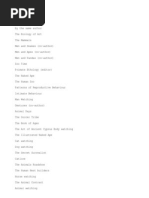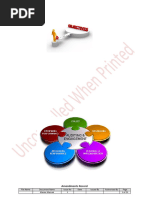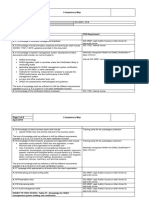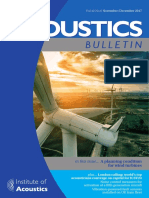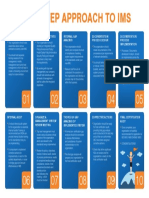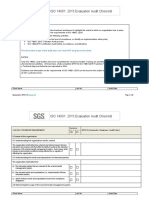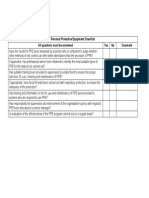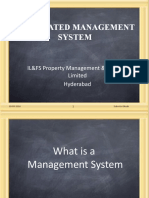100%(1)100% found this document useful (1 vote)
348 viewsISO 14001 Matrix
ISO 14001 Matrix
Uploaded by
AdityaThe document compares the sections and structure of ISO 14001:2015 and ISO 14001:2004. Some of the key differences include:
- ISO 14001:2015 includes additional sections on understanding the organization's context and interested parties' expectations.
- Leadership and commitment is addressed in section 5 instead of 4.4.1 in the previous version.
- Planning now includes addressing risks associated with threats and opportunities.
- Support is covered in section 7 instead of being integrated into section 4.
- Performance evaluation is addressed in section 9 instead of 4.5.
- Improvement now has its own section 10 instead of being part of section 4.6.
Copyright:
© All Rights Reserved
Available Formats
Download as PDF, TXT or read online from Scribd
ISO 14001 Matrix
ISO 14001 Matrix
Uploaded by
Aditya100%(1)100% found this document useful (1 vote)
348 views1 pageThe document compares the sections and structure of ISO 14001:2015 and ISO 14001:2004. Some of the key differences include:
- ISO 14001:2015 includes additional sections on understanding the organization's context and interested parties' expectations.
- Leadership and commitment is addressed in section 5 instead of 4.4.1 in the previous version.
- Planning now includes addressing risks associated with threats and opportunities.
- Support is covered in section 7 instead of being integrated into section 4.
- Performance evaluation is addressed in section 9 instead of 4.5.
- Improvement now has its own section 10 instead of being part of section 4.6.
Original Title
ISO 14001 matrix
Copyright
© © All Rights Reserved
Available Formats
PDF, TXT or read online from Scribd
Share this document
Did you find this document useful?
Is this content inappropriate?
The document compares the sections and structure of ISO 14001:2015 and ISO 14001:2004. Some of the key differences include:
- ISO 14001:2015 includes additional sections on understanding the organization's context and interested parties' expectations.
- Leadership and commitment is addressed in section 5 instead of 4.4.1 in the previous version.
- Planning now includes addressing risks associated with threats and opportunities.
- Support is covered in section 7 instead of being integrated into section 4.
- Performance evaluation is addressed in section 9 instead of 4.5.
- Improvement now has its own section 10 instead of being part of section 4.6.
Copyright:
© All Rights Reserved
Available Formats
Download as PDF, TXT or read online from Scribd
Download as pdf or txt
100%(1)100% found this document useful (1 vote)
348 views1 pageISO 14001 Matrix
ISO 14001 Matrix
Uploaded by
AdityaThe document compares the sections and structure of ISO 14001:2015 and ISO 14001:2004. Some of the key differences include:
- ISO 14001:2015 includes additional sections on understanding the organization's context and interested parties' expectations.
- Leadership and commitment is addressed in section 5 instead of 4.4.1 in the previous version.
- Planning now includes addressing risks associated with threats and opportunities.
- Support is covered in section 7 instead of being integrated into section 4.
- Performance evaluation is addressed in section 9 instead of 4.5.
- Improvement now has its own section 10 instead of being part of section 4.6.
Copyright:
© All Rights Reserved
Available Formats
Download as PDF, TXT or read online from Scribd
Download as pdf or txt
You are on page 1of 1
ISO 14001:2015 vs.
ISO 14001:2004 —Comparison Matrix
ISO 14001:2015 ISO 14001:2004
Scope 1 1 Scope
Normative References 2 2 Normative References
Terms and Definitions 3 3 Terms and Definitions
Context of Organization 4 N/A N/A
Understanding the Organization and its 4.1 N/A N/A
Context
Understanding the Needs and 4.2 N/A N/A
Expectations of Interested Parties
Determining the Scope of the 4.3 4.1 General Requirements
Environmental Management System
Environmental Management System 4.4 4.1 General Requirements
Leadership 5 4.4 Implementation and Operation
Leadership and Commitment 5.1 4.4.1 Resources, Roles, Responsibility and Authority
Environmental Policy 5.2 4.2 Environmental Policy
Organizational Roles, 5.3 4.4.2 Competence, Training and Awareness
Responsibilities and Authorities
Planning 6 4.3 Planning
Actions to Address Risk Associated with 6.1 N/A N/A
Threats and Opportunities
General 6.1.1 4.3.1 Environmental Aspects
Significant Environmental Aspects 6.1.2 4.3.1 Environmental Aspects
Compliance Obligations 6.1.3 4.3.2 Legal and other requirements
Risks Associated with Threats and 6.1.4 N/A N/A
Opportunities
Planning to Take Action 6.1.5 4.3.3 Objectives, Targets and Programs
Environmental Objectives and planning to 6.2 4.3.3 Objectives, Targets and Programs
Achieve them
Environmental Objectives 6.2.1 4.3.3 Objectives, Targets and Programs
Planning Actions to Achieve 6.2.2 4.3.3 Objectives, Targets and Programs
Environmental Objectives
Support 7 4.4 Implementation & Operation
Resources 7.1 4.1.1 Resources, Roles, Responsibilities and Authorities
Competence 7.2 4.4.2 Competence, Training & Awareness
Awareness 7.3 4.4.2 Competence, Training & Awareness
Communication 7.4 4.4.3 Communication
General 7.4.1 4.4.3 Communication
Internal Communication 7.4.2 4.4.3 Communication
External Communication 7.4.3 4.4.3 Communication
Documented Information 7.5 4.4.4 Control of Documents
General 7.5.1 4.4.4 Control of Documents
Creating and Updating 7.5.2 4.4.5 Control of Documents
Control of Documented Information 7.5.3 4.5.4 Control of records
Operation 8 4.4.6 Operational Control
Operational Planning and Control 8.1 4.4.6 Operational Control
Emergency Preparedness and Response 8.2 4.4.7 Emergency Preparedness and Response
Performance Evaluation 9 4.5 Checking
Monitoring, Measurement, Analysis and 9.1 4.5.1 Monitoring and Measurement
Evaluation
General 9.1.1 4.5.1 Monitoring and Measurement
Evaluation of Compliance 9.1.2 4.5.2 Evaluation of Compliance
Internal Audit 9.2 4.5.5 internal Audits
Management Review 9.3 4.6 Management Review
Improvement 10 4.6 Management Review
Nonconformity and Corrective Action 10.1 4.5.3 Nonconformity, Corrective Action and
Preventative Action
Continual Improvement 10.2 N/A N/A
You might also like
- Urgent Care Business Plan ExampleDocument51 pagesUrgent Care Business Plan ExampleJoseph QuillNo ratings yet
- EMS Manual TemplateDocument6 pagesEMS Manual Templateismail mijasNo ratings yet
- Internal Audit Checklist 14001Document10 pagesInternal Audit Checklist 14001sendutdutNo ratings yet
- Sensory Profile PowerpointDocument21 pagesSensory Profile PowerpointLama NammouraNo ratings yet
- ISO 14001-45001-18001 ComparisonDocument11 pagesISO 14001-45001-18001 ComparisonhemavanteruNo ratings yet
- SOP For Compressed Air SystemDocument14 pagesSOP For Compressed Air SystemAbeer arif100% (1)
- Desmond Morris - Baby WatchingDocument103 pagesDesmond Morris - Baby Watchingdeseixas100% (2)
- SAMPLE NCP For Diabetes InsipidusDocument3 pagesSAMPLE NCP For Diabetes InsipidusClancy Anne Garcia Naval50% (2)
- Autogenic TrainingDocument79 pagesAutogenic Traininglazzi89% (9)
- Ems 14001Document57 pagesEms 14001Sarmad Hussain50% (2)
- IMS ManualDocument62 pagesIMS ManualKimpoh Chai100% (1)
- IMS ManualDocument25 pagesIMS ManualANTONIO ZANNININo ratings yet
- Safety Manual For Construction WorkersDocument209 pagesSafety Manual For Construction WorkersEasy TalkNo ratings yet
- Diagram of ISO 45001 Risk Management enDocument1 pageDiagram of ISO 45001 Risk Management enSarabjit Singh SanghaNo ratings yet
- Environmental Management System, Aspect Impact RegisterDocument2 pagesEnvironmental Management System, Aspect Impact RegisterBhagavat PatilNo ratings yet
- A Guide To ISO 45001 PDFDocument8 pagesA Guide To ISO 45001 PDFRoxanaMaguiNo ratings yet
- 4 CQI - IRCA Code of ConductDocument2 pages4 CQI - IRCA Code of ConductArif Rizwan100% (1)
- 03 OH&S ManualDocument11 pages03 OH&S ManualEsther RayeNo ratings yet
- IMS Project Implementation Plan - Rev 2 (111019)Document1 pageIMS Project Implementation Plan - Rev 2 (111019)Biell BaleNo ratings yet
- 9104 2a FormdDocument3 pages9104 2a Formdkarthi keyan100% (1)
- ISO 14001 Ver 2015Document12 pagesISO 14001 Ver 2015Resya Andita PutriNo ratings yet
- Risk RegisterDocument8 pagesRisk RegisterStephenNo ratings yet
- Tool Box Safety Meeting MinutesDocument4 pagesTool Box Safety Meeting MinutesSaravanan GenganNo ratings yet
- ISO 9-14-45K ComparisionDocument6 pagesISO 9-14-45K ComparisionEla MuruganNo ratings yet
- Syllabus ISO 45001-2018 AllDocument13 pagesSyllabus ISO 45001-2018 Allili meylianaNo ratings yet
- Awareness Program On IMS: Integrated Management SystemDocument58 pagesAwareness Program On IMS: Integrated Management SystemK R Kumar RanjanNo ratings yet
- ISO 14001 v. 2004Document61 pagesISO 14001 v. 2004HSSE SGMWNo ratings yet
- IMS Audit CriteriaDocument1 pageIMS Audit CriteriaVenkateshNo ratings yet
- 02 ISO 9001 2015 Awareness & TransitionDocument59 pages02 ISO 9001 2015 Awareness & TransitionSyed Maroof Ali100% (1)
- 14.procedure For EMS Internal AuditsDocument8 pages14.procedure For EMS Internal AuditsDendi Pradeep ReddyNo ratings yet
- Competency Map ISO 45001 - 2018 - April 2018Document8 pagesCompetency Map ISO 45001 - 2018 - April 2018Mohamed HabibNo ratings yet
- How To Budget An ISO 45001 Implementation ProjectDocument12 pagesHow To Budget An ISO 45001 Implementation ProjectShahnawaz PathanNo ratings yet
- Acoustics Bulletin November-December 2017 - 0 PDFDocument72 pagesAcoustics Bulletin November-December 2017 - 0 PDFdjossNo ratings yet
- ISO 14001 Training Program Template: (Organization Name)Document2 pagesISO 14001 Training Program Template: (Organization Name)Washington coaquira ccahuaNo ratings yet
- Legal Audit Checklist OhsDocument24 pagesLegal Audit Checklist Ohspjosesm100% (1)
- NQA 10 Steps To IMS Guide 7 10 2016 - 1Document1 pageNQA 10 Steps To IMS Guide 7 10 2016 - 1Norman AinomugishaNo ratings yet
- Adidas (SEA Environment), Environmental Good Practice Guide Toolkit (EGPG), (2019) (99 SlidesDocument99 pagesAdidas (SEA Environment), Environmental Good Practice Guide Toolkit (EGPG), (2019) (99 SlidesSumeet GillNo ratings yet
- ISO 14001 - High Level StructureDocument1 pageISO 14001 - High Level StructureМиша Макух100% (2)
- EHS Awareness ISO 14001-45001Document52 pagesEHS Awareness ISO 14001-45001hirenNo ratings yet
- Chemical Safety COSHH MSDSDocument23 pagesChemical Safety COSHH MSDSPriyanka JNo ratings yet
- Appendix 3 EMS AUDIT CHECKLISTDocument9 pagesAppendix 3 EMS AUDIT CHECKLISTSharif KhanNo ratings yet
- EMS Aspect Impact Work BookDocument52 pagesEMS Aspect Impact Work Bookcdmguide5985100% (3)
- IntegratedManagementSystemsISO9001 2015ISO14001 2015ISO45001 2018andtheirImportanceinBusinessManagementDocument9 pagesIntegratedManagementSystemsISO9001 2015ISO14001 2015ISO45001 2018andtheirImportanceinBusinessManagementrsoasadigmoniem2023No ratings yet
- ISO 9000-2008 AuditingDocument23 pagesISO 9000-2008 AuditingMohamed ShabirNo ratings yet
- Aspect and Impact AnalysisDocument12 pagesAspect and Impact AnalysisAamir Mukhtar100% (1)
- EHQMS Context & Interested PartiesDocument7 pagesEHQMS Context & Interested PartiesAlfiNo ratings yet
- CD05 UoG Legal RegisterDocument20 pagesCD05 UoG Legal RegisterKingsley AhanonuNo ratings yet
- IMS Implementation Plan & TimelineDocument2 pagesIMS Implementation Plan & TimelineBadhur ZamanNo ratings yet
- FM ENV 003 EMS ManualDocument33 pagesFM ENV 003 EMS ManualAnggoro Antono100% (1)
- Road Safety Crossword 1Document2 pagesRoad Safety Crossword 1Kanageswary Sai0% (1)
- Aspect Impact RegisterDocument17 pagesAspect Impact RegisterVi KraNo ratings yet
- Legal Register Preample Rev.03 15.04.18Document4 pagesLegal Register Preample Rev.03 15.04.18Amit ChahandeNo ratings yet
- 0.checklist, GP3113 ISO 14001 2015 EvaluationDocument29 pages0.checklist, GP3113 ISO 14001 2015 EvaluationAshraf SeragNo ratings yet
- Health & Safety Root Cause Analysis Report TemplateDocument6 pagesHealth & Safety Root Cause Analysis Report Templateganesh.padmavati1100% (1)
- Ims MRM PDFDocument2 pagesIms MRM PDFilayaraja MKNo ratings yet
- Ppe ChecklistDocument1 pagePpe ChecklistIvan BaraćNo ratings yet
- Iso Ims Cross ReferenceDocument24 pagesIso Ims Cross ReferencePraneshNo ratings yet
- Environmental Aspects & Impacts Register 2023Document7 pagesEnvironmental Aspects & Impacts Register 2023Tamara Johnson-PariagNo ratings yet
- Summary of Iso 90091Document3 pagesSummary of Iso 90091Ihuhwa Marta TauNo ratings yet
- IMS Managment Review MeetingDocument17 pagesIMS Managment Review Meetingjafar imamNo ratings yet
- IMS APEX Manual Final LOCODocument64 pagesIMS APEX Manual Final LOCOMarjorie Dulay Dumol100% (1)
- ISO 9001 2015 Gap Analysis Checklist Sample PDFDocument4 pagesISO 9001 2015 Gap Analysis Checklist Sample PDFmilou88No ratings yet
- Integrated Management System: IL&FS Property Management & Services Limited HyderabadDocument27 pagesIntegrated Management System: IL&FS Property Management & Services Limited HyderabadSubroto Ghosh100% (4)
- Iso 14001Document12 pagesIso 14001PareshMangalNo ratings yet
- Global Oshdata: Ilo Report: Fatal Work-Related Accidents Every YearDocument11 pagesGlobal Oshdata: Ilo Report: Fatal Work-Related Accidents Every YearJohn Paul Marin Manzano100% (1)
- Public Notice For Withdrawal of Bancassurance Products Wef 01.06.2021 - 24 - 02 - 21Document1 pagePublic Notice For Withdrawal of Bancassurance Products Wef 01.06.2021 - 24 - 02 - 21Siddhartha PorwalNo ratings yet
- Joseph Lugaho ReportDocument21 pagesJoseph Lugaho ReportAbraham owinoNo ratings yet
- Learning Journal Unit 8-Health ScienceDocument3 pagesLearning Journal Unit 8-Health ScienceRUKAYAT LASISINo ratings yet
- The Third & Fourth Misconception - The Fallacy of Pragmatism & SociologismDocument3 pagesThe Third & Fourth Misconception - The Fallacy of Pragmatism & SociologismYui EsAnNo ratings yet
- Brochure - Sambhav Initiative.Document28 pagesBrochure - Sambhav Initiative.Vijay GautamNo ratings yet
- Gamapatiile Monoclonale PDFDocument92 pagesGamapatiile Monoclonale PDFJimboreanu György PaulaNo ratings yet
- Jurnal Nilai Kritis LabDocument16 pagesJurnal Nilai Kritis LabAmalia EnggarNo ratings yet
- IS 105 Technical Writing IMDocument44 pagesIS 105 Technical Writing IMErika Mae Jaranilla75% (4)
- Suri ArjunDocument2 pagesSuri ArjunyauliyacuNo ratings yet
- solution_630Document16 pagessolution_630AbdulWadoodAl-SatrawiNo ratings yet
- Nelson Textbook of Pediatrics 20th Edition Robert M. Kliegman - Ebook PDF 2024 Scribd DownloadDocument49 pagesNelson Textbook of Pediatrics 20th Edition Robert M. Kliegman - Ebook PDF 2024 Scribd Downloadkapcakziadah100% (2)
- Body Image Survey ResultsDocument1 pageBody Image Survey Resultsapi-260339450No ratings yet
- SBI PO Prelims Memory Based Paper (Held On 22 Nov 2021 Shift 3)Document29 pagesSBI PO Prelims Memory Based Paper (Held On 22 Nov 2021 Shift 3)dragondevilgod999No ratings yet
- OB-GYN 250 2 (Block 3) DignityDocument19 pagesOB-GYN 250 2 (Block 3) DignityRommel OliverasNo ratings yet
- AzozDocument18 pagesAzozEshaq Al-BishiNo ratings yet
- Test Unit 2 UpdateDocument4 pagesTest Unit 2 UpdateАнна ВолобоєваNo ratings yet
- Assignment!: Complete The SentencesDocument3 pagesAssignment!: Complete The SentencesFiska Maida100% (1)
- 1 s2.0 S0020138323006873 MainDocument6 pages1 s2.0 S0020138323006873 MainAliif MaulanaNo ratings yet
- St. Thomas School, Indirapuram Civics, Clas 8 CH-10, Law and Social JusticeDocument3 pagesSt. Thomas School, Indirapuram Civics, Clas 8 CH-10, Law and Social Justicepvishnuvardhan2022No ratings yet
- Discrimination of Metastatic From Acute Osteoporotic Compression Spinal Fractures With MRIDocument9 pagesDiscrimination of Metastatic From Acute Osteoporotic Compression Spinal Fractures With MRIChow Tat SingNo ratings yet
- Melanie Klein's Object Relations TheoryDocument11 pagesMelanie Klein's Object Relations TheoryScribdTranslationsNo ratings yet
- Exercise For UasDocument4 pagesExercise For UasByy InaraNo ratings yet
- PDF Social Networks and Health Models Methods and Applications 1st Edition Thomas W. Valente DownloadDocument84 pagesPDF Social Networks and Health Models Methods and Applications 1st Edition Thomas W. Valente Downloadtoochiufere100% (5)








